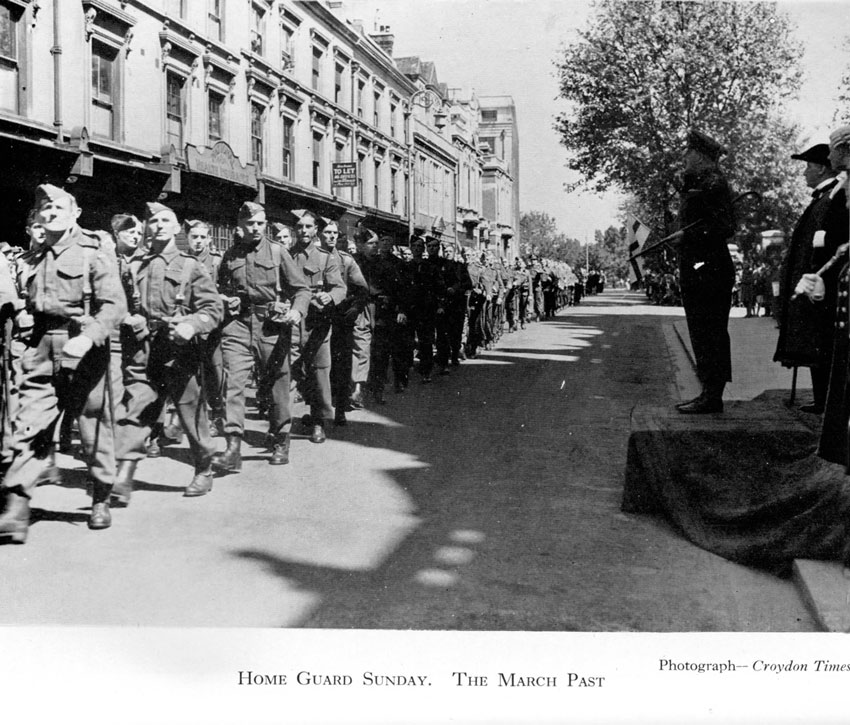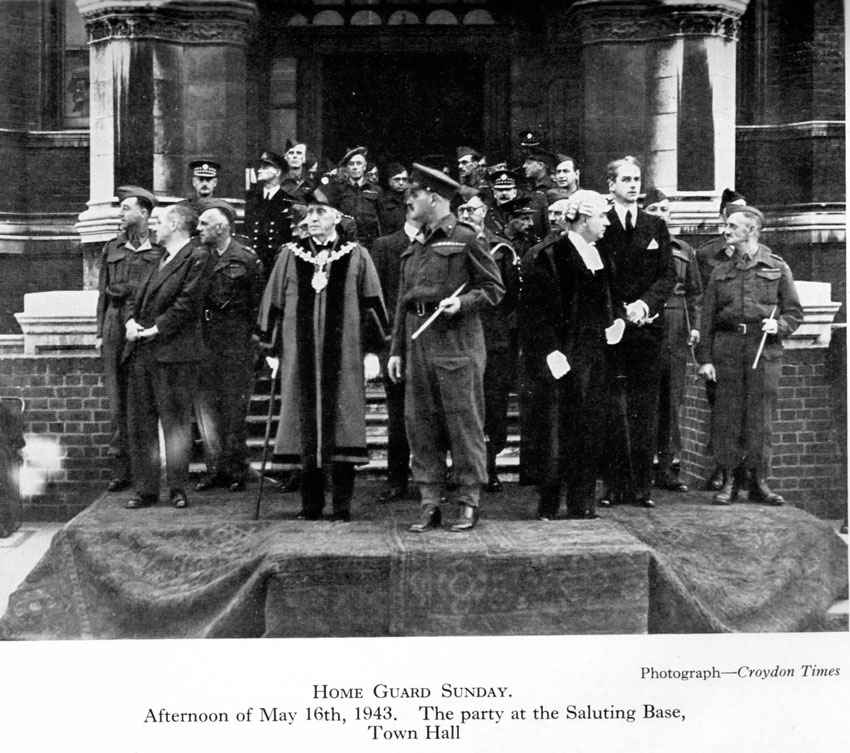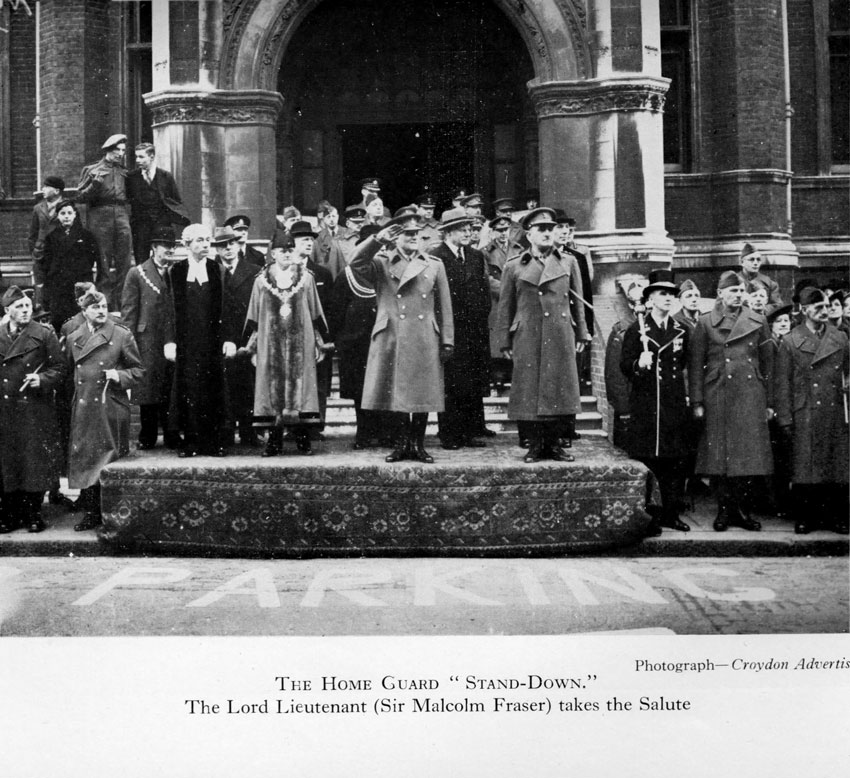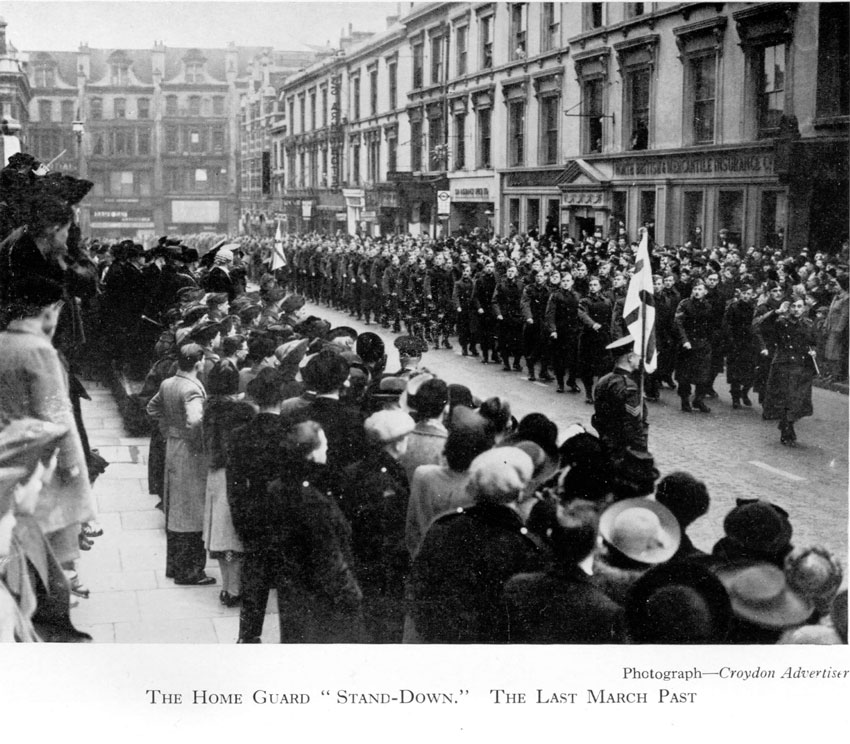This is a page within the www.staffshomeguard.co.uk website. To see full contents, go to SITE MAP.
MEMORIES
AND INFORMATION - SURREY
THE CROYDON HOME GUARD
A BRIEF
HISTORY
|
The Croydon
Home Guard is regarded as having comprised the
following Battalions:
58th Surrey
(Purley),
59th Surrey (Addington),
61st Surrey (Norwood),
62nd Surrey (Norbury),
31st London (Streatham),
32nd Surrey (Factory)
and
33rd Surrey (Corporation).
In the immediate
post-war years, Croydon Corporation issued a
commemorative book entitled
"Croydon in the
Second World War" by
W.C. Berwick
Sayers. Within it was a section,
invaluable to Home Guard historians and to
local and family history researchers, giving a
summary of Home Guard activities in the area
between 1940 and 1944. In the interest of
preserving this material and making it
accessible to a wider, 21st century audience,
this page contains a transcript of the
author's description and the four accompanying
images.
A full acknowledgement is given
at the foot of the page.
|
|
CREATION OF
THE LOCAL DEFENCE VOLUNTEERS |
On
Tuesday, May 14th,
1940, Mr.
Anthony Eden, Secretary of State for
War, broadcast an appeal which resulted in the
most dramatic response in the history of
volunteer citizen armies. Germany had struck
in the West; in four days, Holland had fallen,
largely through inadequate defence against
violent aerial bombardment and innumerable
parachutists; Belgium was again invaded; soon
the B.E.F. would make its desperate but
brilliant evacuation, and France was to fall.
Mr. Eden called for an army of unpaid,
part-time volunteers to defend their homes,
and to face the threat of imminent invasion.
The response in the
Croydon area was immediate. Throughout
the country applicants poured to the appointed
stations, and, in a few days, half a million,
and in a few weeks, one and three-quarter
millions were functioning as an organization
of local forces, self-created, without
recourse to the aid of the Army, and with only
general directions from the War Office.
The task of
organizing this great Force in the
"Z" Metropolitan
Zone (comprising
Croydon,
Beddington
and Wallington,
Coulsdon and
Purley,
Warlingham and
Streatham),
was entrusted on
May 20th to
Major Norman C. Gillett, a retired
officer of the
Royal Tank Corps, lately
D.A.A.G., 1st
Armoured Division. He immediately
decided to concentrate his first attention on
the defence of the open country and approaches
south and east of Croydon, which he
constituted in the following areas:
I.
Purley
Sub-zone:
under
Captain
Bruce Humfrey, J.P., I.A.
(retired), later Chairman of the
Croydon County Bench, a battalion of
three Company groups, West, Central
and East, in a half circle ranging
round Croydon.
II.
Addington
Sub-zone:
a double group
east of
Croydon, and including
Shirley,
under
Captain E. B. Loveluck, late of
the Indian
Staff College.
III.
Coulsdon Sub-zone:
a double
group south
of Purley, and including most
of Kenley,
under
Captain R. H. Hudson, retired.
IV.
Warlingham
Group:
covering
south-eastern approaches, under
Captain
Ambrose Keevil,
M.C.,
late
Munster Fusiliers. |
The principal organizers received only an
area, some bundles of application forms, the
promise of fifty rifles per group, and
authority to recruit three men per rifle on a
brief question and answer basis. With eager
helpers, however, they worked day and night,
during the rest of May, in surveying their
areas, marking out sectors, fixing observation
posts, rendezvous and patrol areas, perusing
applications, calling up, interviewing and
enrolling applicants, selecting, appointing
and instructing platoon and section
commanders, obtaining and equipping suitable
headquarters, concerting tactical, defensive
and training measures, collecting such little
uniform and equipment as they could, and
making contact with police, civil defence
services and local military organizations and
neighbouring formations.
So the
movement started without documentary authority
or instruction, or any recruiting,
administrative and training staff,
accommodation, supplies, transport or finance.
The general idea was to form as many groups of
three men as possible. Of these, No. 1 was
rifleman and in charge, with the prime duty of
offence, No. 2 was handyman, observer and
support, while No. 3 was runner, preferably
with car or cycle, and the prime duty of
communications. This provided all the elements
of an observation post, guard or patrol, with
three reliefs, and ready security for rifle,
bolt and ammunition. The formula which
remained the keynote of the service was, "See,
tell, hit" with constant observation for
the expected airborne enemy, immediate report
back, and instant attack upon any landing.
Meanwhile,
Major Gillett was gathering the nucleus of his
Zone H.Q. staff, first at
5, Friends Road,
and later at 4,
Fell Road. This included
Mr. Frank Harwood,
M.C. (late R.A.), and
Major S. R.
Docking, T.D., an ever-young Croydon
veteran who had commanded the Croydon column
of the S.E. Mounted
Brigade Transport and Supply Column, A.S.C.
in the 1914-18 war. Major Gillett negotiated
contacts and boundaries with neighbouring
Zones, formed special "Factory" and "Utility"
units, and tackled the question of the "back
areas". For these, at that time, there were
neither arms nor the prospect of them. Their
provisional role was to supply unarmed bodies
to support the police, and they were organized
under the general supervision of
Brigadier-General
Hanbury in four areas (Croydon
Central,
Norwood,
Norbury and
Streatham).
By the end
of May, this spate of activity had evolved a
great organization, prepared to give a serious
account of itself, and keeping constant watch
and ward from the outset. From
May 25th,
observation posts were manned nightly; on
May 26th
arms, ammunition and uniform were drawn and
parades held; on
May 31st a general "stand-to" found
Croydon's new defences tested and tried. The
original preparations for invasion from the
air were being supplemented by preparations to
meet a hostile advance on land; and such
offensive weapons as could be issued, begged,
borrowed or invented were being brought into
use and position, with ready aid from
engineers, scientists and veterans, whose
experience enriched the new Force.
|
|
SUMMER AND
WINTER, 1940-41 |
The pace of
activity and growth in the first few weeks was
too rapid to be maintained by the original
pioneers, who all had their personal business
and domestic cares as well as public
responsibilities. Once the organization was
actively functioning they looked for others,
well-fitted and with time available to give to
work which demanded every ounce of energy.
Major Gillett was fortunate enough to find
Major-General N. G.
Anderson, C.B., C.M.G., D.S.O., ready
to take over command of the Zone and to give
all his wise counsel and experienced guidance
to all leaders and ranks.
The
Purley
Battalion (Z1), was gradually re-organized
under the command of
Captain Haine, V.C.,
giving up the
Sanderstead Company, and taking in the
South Croydon
Company under
Councillor Berners Price, and the
Coulsdon
Sub-zone.
The
Addington Sub-zone was enlarged into a
Battalion (Z2), taking in the
Sanderstead
Company and the
Warlingham Group, under
Mr. H. Pierce, J.P.;
this Battalion contained the only mounted
section and patrol.
The back areas were
now gradually being armed, in four Battalions,
Croydon, Norwood,
Norbury and
Streatham (Z3, Z4, Z5 and Z6).
The
central group of factories was formed into a
Battalion (Z7), first under
Mr. C.
Renton-Coomber, and then under
Councillor (now
Alderman) Basil Monk, while ...
The
enrolled details of Corporation services in
Croydon
became a Municipal Battalion (Z8), under
Mr. H. F. Hughes,
D.C.M.
Gradually, the
authorities realised that this great infant
force was worthy of more encouragement in men,
money and material. The original annual
allowance of 2/6
(12.5p)
per man was increased by more noticeable
grants, a paid whole-time administrative
assistant was sanctioned for each battalion,
to which a clerk was added later, and the Zone
obtained a Weapons Instructor in
Sgt. (later
C.S.-M.) Coombs. Marksmanship was
diligently practised, both at Bisley and on
local ranges, with the original rifles, and
afterwards with automatic weapons.
The Prime
Minister, with his flair for the bon mot,
gave the Local Defence Volunteers their new
neat, though possibly less precise designation
of "The Home Guard." On
August 15th, 1940,
the Home Guard of the
Croydon and
Purley
Battalions and Factory units helped long into
the first tragic night of aerial bombardment;
after which, as raids continued, they did
yeoman work and earned commendation. Time
after time, invasion seemed inevitable, but
still nothing happened.
(Webmaster
note: Active Home Guard involvement in the
defence against enemy attack of course
continued and included daytime raids.
Three days later, on Sunday, August 18th,
Kenley Aerodrome was subject to a heavy attack
which involved significant loss of life
including that of
William Battle
of the 58th
Surrey (Purley) Battalion.)
Apart from
those who gradually departed in the
Field Army,
it is remarkable how very few volunteers fell
out. Men engaged in guard duty or training,
after a hard day at their civilian work,
without greatcoats on wet, cold winter nights,
without helmets in the midst of raids, were
animated by no mere burst of enthusiasm, but
by a constant sense of urgent and desperate
need.
Many names
could be mentioned of those who helped for
varying periods, for example,
Lieut.-General Sir
Douglas Brownrigg, K.C.B., late
Adjutant-General to the B.E.F., who acted as
General Anderson's assistant for some time,
but the Zone's achievements were attained by
the combined efforts of those thousands whom
it is impossible to name individually.
Until
April, 1941,
the "citizen army" aspect was maintained by a
complete absence of ranks, save those derived
from earlier Army service. All were simple
volunteers, exercising such authority as was
inherent in the particular job undertaken by
each. In April,
however, the War Office decided to bring the
civilian army into line with the Field Army by
conferring ranks to accompany special
appointments. These were not automatically
higher rank, as for example,
Major-General
Anderson, who became a Colonel, H.G.
Medical Officers were appointed, and the
Bishop of Croydon
became Zone Chaplain, but without pay or
allowance of any rank.
|
|
THE HOME
GUARD'S SECOND YEAR, 1941-42 |
In May or June,
1940, anyone would have ridiculed a prophecy
that twelve months would elapse without
invasion, but the miracle happened, and when,
on June 22nd, 1941,
Hitler attacked
Russia, the Home Guard felt able for
the first time, to develop long-term training
and organization. Collective, intensive,
specialist and staff training in Battalions,
in Zones, pools and courses, and away at
special schools and with Regular Units were
the dominant notes of the second year. The
Home Guard had been instituted and it had
found its feet; now it was getting fit and
ready for whatever form of attack the enemy
might make. Changes in personnel occurred
steadily, but merely as individual
enlistments, promotions and retirements. Arms
and equipment continued to arrive, but never
quickly enough for the men.
For the greater
number, training meant weapon training, field
exercises, street fighting and unarmed combat.
As to the first, the awkward journey to
Bisley was
no longer necessary, practice took place at
Worms Heath,
Tillingdown
and Marlpit Lane.
Demonstrations were given and zest fostered by
competitions between units, while physical
fitness was toned up by route marches. The
"State" and
other cinemas became centres of military
education by means of the screen.
Appropriate courses
took the commanders, from section N.C.O.s and
platoon officers upward, further afield to
London and
Dorking, and
into contact with officers from other zones,
near and far. Within the Zone,
Lieut.-Colonel
Keevil, as Assistant Zone Commander,
formed first a Zone Instructional Centre, and
then instituted special lectures, tours,
tactical exercise without troops and
conferences, with the ideal of lively and
efficient cohesion. Fieldcraft and camouflage
were studied and practised, while at Zone H.Q.
and in Battalions, intelligence and signal
sections were formed. Battle organization was
learned and practised in liaison with Field
Army units, neighbouring Home Guard, police,
and civil defence services. Of particular
interest, too, was the formation of the
Whitgift
Intelligence Section, which was, in
effect, a Staff College for boys of both the
Whitgift
Schools.
By the end of the
second year the Home Guard role had advanced
from preparing to tackle parachutists to
undertaking the primary defence of our
islands, thus freeing the Field Army for duty
elsewhere. The policy of conscription had been
sanctioned, but not put into operation; the
right to resign had been taken away; all
service was still unpaid, but necessary
expenses were refunded. The Home Guard was
accepted as an integral part of the armed
forces of the Crown, with H.M. the King as
Colonel-in-Chief.
|

Throughout the year
1942-43 the Home Guard continued to operate on
the same lines as before, though, with the
development of the war effort, changes in
role, personnel and organization inevitably
occurred.
Although, by the
summer of 1942,
the danger of invasion had receded, the Home
Guard became a defence force to an even
greater extent against the real danger of
diversionary attacks. Thus it freed the
Regular Army for tasks further afield. So far,
such attacks were coming only from greatly
reduced air assaults, and the Home Guard took
over anti-aircraft defence and raised
batteries which quickly went into action,
notably in the
London area. To cope with its increased
responsibilities, the Home Guard's mechanized
transport and signal services were augmented
and developed.
In
May,
Major-General Anderson, who had so admirably
commanded the Zone since July, 1940, retired
and was succeeded by
Colonel Keevil
as Zone Commander, with
Lieut.-Colonel
Harwood as Deputy. Thus, two of the
original organizers of May, 1940, reached
command of the area in two years. From its
early days, the Zone was fortunate in finding
within its own borders, born commanders who,
like most of its personnel, succeeded in
performing arduous military duties while
pursuing civil occupations; there was
therefore no need to bring in senior
commanders from the Regular Army.
Other changes
gradually occurred, because of the calling-up
of younger men and the death or retirement of
older ones, and unfortunately because of
casualties on duty, in raids or on ranges.
Particularly regretted was the death of
Lieut.-Colonel
Harold Webster, the universally
respected and loved C.O. of the
61st (Norwood)
Battalion, and
Parks
Superintendent of Croydon.
Substantially, however, the earliest
volunteers continued to carry the main burden
with the welcome and steady influx of young
recruits already well versed and trained in
arms. This last was due to one of the features
of the third year of the war. This was the
creation of Youth Forces and their expanding
influence on boys and girls; the gap between
Scouts and Guides on one hand and the Services
on the other being bridged now not only by the
O.T.C. and
Cadet Corps
of the great schools, but also by the national
pre-Service bodies, the
A.T.C., Sea Cadets,
Army Cadet Force, G.T.C. and
W.J.A.C.,
which now flourished in the district and, on
the male side, proved valuable training
schools for the Home Guard as well as the
Services. In this year, too, the strong desire
of many women to serve at last obtained
recognition and the Zone Headquarters and
Battalions all received contingents of women
volunteers who were often anxious to do much
more than the duties assigned to them.
A fitting climax to
the year came with the King's inspection of
local contingents in
Hyde Park,
the Prime Minister's broadcast tribute from
Washington
and the stirring anniversary parades on "Home
Guard Sunday"! throughout the Zone, whose
title had now been changed to "Sector" and
which had at last obtained a more fitting
Headquarters in
Poplar Walk.
May 16th, 1943,
was celebrated throughout the country as "Home
Guard Sunday," it being the third anniversary
of the inauguration of Local Defence
Volunteers. In the morning, each Battalion in
the "Z"' Metropolitan District prepared an
independent programme. These consisted mainly
of route marches, and one of the most
spectacular was that of the
33rd Battalion at
Duppas Hill.
The officers and men marched from
Fairfield,
and the salute was taken by the Commanding
Officer (Lieut.-Colonel
H. F. Hughes) and
Councillor Engineer
Rear-Admiral Harrison. The column was
headed by the band of the
Whitgift J.T.C.
The spectators saw mock operations, including
a "gas attack."
A service was held
in the afternoon at the
Grand Theatre.
The address was given by the
Rev. W. C. Lee,
Senior Chaplain to the Forces, and
Colonel Keevil
read the Lessons. The parade, led by
Lieut.-Colonel
Harwood (Assistant Sector Commander)
and Major Waller
(Sector Training Officer) included the
31st, 32nd, 33rd,
58th, 59th, 60th, 61st and 62nd Surrey
Battalions and detachments from six
neighbouring battalions. They marched from
Fairfield,
led by the band of the
1st Leicesters.
Colonel Keevil took the salute at the
Town Hall.
|

|
1943 and
1944, D DAY, DOODLES and STAND DOWN |
Still long months
passed of tense waiting, with two minor
blitzes; during one of which died
Lieut.-Colonel
Frank Harwood, Deputy Sector Commander,
to whose constant zeal "Z" Sector had owed as
much as to anyone in four years of strain.
When "D" Day came
the Sector had secretly for weeks been under
special orders, but had to adapt itself, and
did so readily to duties never contemplated.
No armed German at this time reached our
shores or skies, but the H.G. A.A. batteries
did yeoman service against the flying bomb,
and were not content with the duties assigned
to them. Time and again they insisted on
taking over from regular gunners, worn out by
strenuous duty. The battalions with no live
targets often found scope for valuable
constructive, instead of destructive, service.
Wherever homes were wrecked in "Z" sector, the
worst hit area of all, Home Guards were at
once on the spot rendering first aid to the
stricken dwellings. In one of these homes was
Major N. C. Gillett,
the original organizer and Zone commander of
the L.D.V., who succumbed as a result of this
last blow after many years of fine public
service.
When the Field Army
reached Germany the Cabinet decided that the
Home Guard had fulfilled its mission and
should now "stand down" to release its
members' time and energy for other pressing
tasks. Amid much conflict of views as to the
wisdom and manner of doing this, the final
orders came through. Crowds witnessed the
final stirring sector parade march past the
Lord Lieutenant of
Surrey and other distinguished visitors
at Croydon Town
Hall on
November 26th, 1944, and a week later
each battalion held its own parade among its
friends with valedictory messages of thanks.
There is,
unfortunately, no space for the names of
upwards of thirty thousand who served, but the
following were the main units and final
commanders:
"Z"
Sector Commander ...
Colonel Ambrose
Keevil, C.B.E., M.C
Deputy
Commander ...
Lieut.-Colonel A. J. Chapman
Battalion Commanders:
58th Surrey (Purley) ...
Lieut.-Colonel R.
L. Haine, V.C., M.C.
59th Surrey (Addington) ...
Lieut.-Colonel H.
E. Pierce, J.P.
60th Surrey (Croydon) ...
Lieut.-Colonel G.
H. Ward, O.B.E.
61st Surrey (Norwood) ...
Lieut.-Colonel F.
L. Walker
62nd Surrey (Norbury) ...
Lieut.-Colonel M.
S. Richardson
31st London (Streatham) ...
Lieut.-Colonel J.
C. W. Grieg
32nd Surrey (Factory) ...
Lieut.-Colonel
Basil Monk, M.B.E., J.P.
33rd Surrey (Corporation) ...
Lieut.-Colonel H.
F. Hughes, D.C.M.
|


*********************
ACKNOWLEDGEMENTS
is gratefully made
to
the author (W.C.
Berwick Sayers) and the publisher (Croydon
Corporation) of "Croydon in the Second World
War", and to their successors, whose specific
permission for the reproduction of this
material has been impossible to obtain because
of the passage of time. The entirely
non-commercial purpose of this website is
simply to commemorate the service of all
members of the Home Guard and to add to our
knowledge of their activities in 1940-1944.
Nevertheless, if anyone feels that their
rights have been unreasonably infringed, they
are asked to contact the webmaster who will
take immediate and appropriate remedial
action.
Grateful acknowledgement is
similarly to made to Will Ward for having
brought this publication to the attention of
staffshomeguard.
|
x182, November 2021 |
|